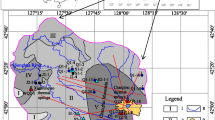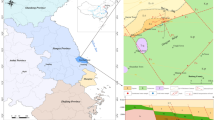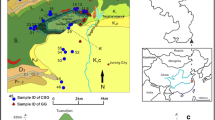Abstract
Kangding geothermal area is located in the western Sichuan, belonging to southeastern margin of Tibetan Plateau. Similar to world-renowned south Tibetan and western Yunnan geothermal belt, western Sichuan has intensive surface thermal manifestations including boiling and hot springs. The emerging temperature of thermal waters ranges from 47 to 79 °C with total dissolved solids lying between 899 and 2550 mg/L. δ2H–δ18O isotopes indicate a meteoric source for the thermal waters and a significant positive oxygen-18 shift in the southern region. It is suggested that southern thermal waters experienced stronger water–rock interaction and are closer to thermodynamic equilibrium, which is also proved by the water type classification. The reservoir temperature calculated by empirical and theoretical chemical thermometry is 180–225 °C for the north and 225–310 °C for the south. Evidences of hydrogeochemistry, stable isotopes, geothermometry and radiocarbon dating indicate that southern region of Kangding area shows greater geothermal potential than the northern region. In addition, based on the hydrogeochemical modeling of mineral saturation, underlying problem of scaling is likely to occur in the study area. According to the results of reservoir temperature, south Kangding sub-district has greater potential in geothermal power generation and development than northern Kangding. Therefore, further exploration and drilling work should give priority to the south Kangding area.





















Similar content being viewed by others
References
Allen CR, Zhuoli L, Hong Q, Xueze W, Huawei Z, Weishi H (1991) Field study of a highly active fault zone: the Xianshuihe fault of southwestern China. Geol Soc Am Bull 103(9):1178–1199
Arnorsson S (ed) (2000) Isotopic and Chemical Techniques in Geothermal Exploration, Development and Use – Sampling Methods, Data Handling, Interpretation. International Atomic Energy Agency, Vienna, Austria, pp 351
Arnórsson S, Gunnlaugsson E, Svavarsson H (1983) The chemistry of geothermal waters in Iceland. III. Chemical geothermometry in geothermal investigations. Geochim Cosmochim Acta 47(3):567–577
Arnórsson S, Andresdottir A, Gunnarsson I, Stefánsson A (1998) New calibration for the quartz and Na/K geothermometers–valid in the range 0–350 °C. In: Proc. geoscience society of Iceland annual meeting, pp 42–43
Blasch KW, Bryson JR (2007) Distinguishing sources of ground water recharge by using δ2H and δ18O. Ground Water 45(3):294–308
Burchfiel B, Zhiliang C, Yupinc L, Royden L (1995) Tectonics of the Longmen Shan and adjacent regions, central China. Int Geol Rev 37(8):661–735
Cao Y, Li H, Liu Z, Yuan D, Shen L (2006) Comparison of geochemical features of warm springs between Chongqing and Kangding. Carsolog Sin 25(2):112–120
Chang EZ (2000) Geology and tectonics of the Songpan–Ganzi fold belt, southwestern China. Int Geol Rev 42(9):813–831
Chen Z (2014) Hydrogeochemistry of the hot springs in western Sichuan Province, Southwestern China after the Wenchuan Ms8.0 earthquake, University of Science and Technology of China
Chen Z, Xu Y, Zheng K (2015) Geochemistry of potential high temperature geothermal resources in Kangding, Sichuan, China. Geochemistry 19:25
Craig H (1961) Isotopic variations in meteoric waters. Science 133(3465):1702–1703
Craig H (1963) The isotopic geochemistry of water and carbon in geothermal areas. In: Tongiorgi E (ed) Nuclear Geology on Geothermal Areas. Spoleto, Italy, pp 17–54
Dansgaard W (1964) Stable isotopes in precipitation. Tellus 16(4):436–468
Ellis AJ, Ellis W, Mahon W (1977) Chemistry and geothermanl systems. Academic Press, New York
Fisher RS, Mullican WF III (1997) Hydrochemical evolution of sodium-sulfate and sodium-chloride groundwater beneath the northern Chihuahuan Desert, Trans-Pecos, Texas, USA. Hydrogeol J 5(2):4–16
Fournier R (1977) Chemical geothermometers and mixing models for geothermal systems. Geothermics 5(1–4):41–50
Fournier R (1979) A revised equation for the Na/K geothermometer. Geoth Resour Counc Trans 3:221–224
Fournier R, Truesdell A (1973) An empirical Na-K-Ca geothermometer for natural waters. Geochimica et Cosmochimica Acta 37(5):1255–1275
Gao J, Masson-Delmotte V, Yao T, Tian L, Risi C, Hoffmann G (2011) Precipitation water stable isotopes in the south Tibetan Plateau: observations and modeling. J Clim 24(13):3161–3178
Giggenbach WF (1988) Geothermal solute equilibria. derivation of Na–K–Mg–Ca geoindicators. Geochim Cosmochim Acta 52(12):2749–2765
Giggenbach W (1991) Chemical techniques in geothermal exploration. Appl Geochem Geotherm Reserv Dev 11:9–144
Giggenbach W, Glover R (1992) Tectonic regime and major processes governing the chemistry of water and gas discharges from the Rotorua geothermal field, New Zealand. Geothermics 21(1–2):121–140
Giggenbach WF, Soto RC (1992) Isotopic and chemical composition of water and steam discharges from volcanic-magmatic-hydrothermal systems of the Guanacaste Geothermal Province, Costa Rica. Appl Geochem 7(4):309–332
Jia G, Wei K, Chen F, Peng PA (2008) Soil n-alkane δD vs. altitude gradients along Mount Gongga, China. Geochim Cosmochim Acta 72(21):5165–5174
Kharaka YK, Mariner RH (1989) Chemical geothermometers and their application to formation waters from sedimentary basins, Thermal history of sedimentary basins. Springer, pp 99–117
Kharaka YK, Lico MS, Law LM (1982) Chemical Geothermometers Applied to Formation Waters, Gulf of Mexico and California Basins: ABSTRACT. AAPG Bulletin 66(5):588–588
Kong Y, Pang Z, Shao H, Shengbiao H, Kolditz O (2014) Recent studies on hydrothermal systems in China: a review. Geothermal Energy 2:19
Larson T, Sollo FW (1967) Loss in water main carrying capacity. J Am Water Works Assoc 59(12):1565–1572
Liu Y (2011) Genesis of the geothermal water in Simaqiao-Xiaoreshui area of Kangding, Sichuan Province. Master Degree thesis, China University of Geosciences, Beijing
Luo L (1994) Inquisition of the distribution and cause of the hot springs in western Sichuan. J Chongqing Teach Coll Nat Sci Ed 11(2):39–47
Meade BJ (2007) Present-day kinematics at the India-Asia collision zone. Geology 35(1):81–84
Nicholson K (2012) Geothermal fluids: chemistry and exploration techniques. Springer Science & Business Media, Berlin
Pang Z (1988) Multiple fluid-mineral equilibrium calculations and their applications to geothermometry and hydrochemical processes in geothermal systems. Rep. of UNU Geothermal Training Programme, National Energy Authority of Iceland, Reykjavik, 88, 5
Pang Z (1991) Calibration of chemical geothermometers based on fluid-mineral equilibrium calculations with application to the hot spring areas in the south of Fujian Province, China. Geotherm Resour Counc Trans 15:273–278
Pang Z (1992) Theoretical calibration of chemical geothermometers and its application to the granitic geothermal areas of SE China. In: Kharaka YK, Maest AS (eds) Water-Rock Interaction, Balkema, pp 1463–1466
Pang Z, Armmannson H (1989) Modeling chemical equilibrium in hydrothermal systems: with examples from Iceland and China. In: Miles L (ed) Water-Rock Interaction, Balkema, pp 541–545
Pang Z-H, Reed M (1998) Theoretical chemical thermometry on geothermal waters: problems and methods. Geochim Cosmochim Acta 62(6):1083–1091
Pasvanoğlu S (2012) Hydrogeochemical study of the thermal and mineralized waters of the Banaz (Hamamboğazi) area, western Anatolia, Turkey. Environ Earth Sci 65(3):741–752
Piper AM (1944) A graphic procedure in the geochemical interpretation of water-analyses. EOS Trans Am Geophys Union 25(6):914–928
Reed M, Spycher N (1984) Calculation of pH and mineral equilibria in hydrothermal waters with application to geothermometry and studies of boiling and dilution. Geochim Cosmochim Acta 48(7):1479–1492
Reed M, Spycher N, Palandri J (2010) SOLVEQ-XPT: a computer program for computing aqueous-mineral-gas equilibria. University of Oregon, Department of Geological Sciences, Eugene, p 43
Roger F, Calassou S, Lancelot J, Malavieille J, Mattauer M, Zhiqin X, Ziwen H, Liwei H (1995) Miocene emplacement and deformation of the Konga Shan granite (Xianshui He fault zone, west Sichuan, China): geodynamic implications. Earth Planet Sci Lett 130(1):201–216
Royden LH, Burchfiel BC, van der Hilst RD (2008) The geological evolution of the Tibetan Plateau. Science 321(5892):1054–1058
Ryznar JW (1944) A new index for determining amount of calcium carbonate scale formed by a water. J Amer Water Works Ass 36:472–486
Scanlon BR, Healy RW, Cook PG (2002) Choosing appropriate techniques for quantifying groundwater recharge. Hydrogeol J 10(1):18–39
Schoeller H (1962) Les eaus souterrians Masson et. Cie, Paris
Shen L (2007) The study of deep source CO2 degasification and carbon cycle in the southwest of China. Southwest University
Su B, Chen Y, Liu F, Wang Q, Zhang H, Lan Z (2006) Geochemical characteristics and significance of Triassic sandstones of Songpan–Ganzi block. Acta Petrol Sin 22(4):961–970
Tarcan G (2005) Mineral saturation and scaling tendencies of waters discharged from wells (>150 °C) in geothermal areas of Turkey. J Volcanol Geoth Res 142(3):263–283
Truesdell A (1976) Summary of section III geochemical techniques in exploration. In: Proceedings of the Second United Nations Symposium on the Development and Use of Geothermal Resources, San Francisco, pp 1iii-1xxix
Vengosh A, Helvacı C, Karamanderesi ISH (2002) Geochemical constraints for the origin of thermal waters from western Turkey. Appl Geochem 17(3):163–183
Wang E (1998) Late Cenozoic Xianshuihe–Xiaojiang, Red River, and Dali fault systems of southwestern Sichuan and central Yunnan. Geological Society of America, China
Wang Y, Liu S, Bian Q, Yan B, Liu X, Liu J, Wang H, Bu X (2015) Scaling analysis of geothermal well from Ganzi and Countermeasures for Anti-scale. Adv New Renew Energy 3(3):202–206
Wei M, Tian T, Sun Y, Li X (2012) A study of scaling trend of thermal groundwater in Kangding county of Sichuan. Hydrogeol Eng Geol 39(5):132–138
Xu G, Kamp PJ (2000) Tectonics and denudation adjacent to the Xianshuihe Fault, eastern Tibetan Plateau: constraints from fission track thermochronology. J Geophys Res Solid Earth 105(B8):19231–19251
Xu Z, Yang J, Li H, Ji S, Zhang Z, Liu Y (2011) On the tectonics of the India-Asia Collision. Acta Geol Sin 85(1):1–33
Yeh H-F, Lee C-H, Hsu K-C (2011) Oxygen and hydrogen isotopes for the characteristics of groundwater recharge: a case study from the Chih-Pen Creek basin, Taiwan. Environ Earth Sci 62(2):393–402
Zhang Y, Hao Z (1991) Regional geology of Sichuan Province. Geological Publishing House, Beijing
Zhang P-Z, Shen Z, Wang M, Gan W, Bürgmann R, Molnar P, Wang Q, Niu Z, Sun J, Wu J (2004) Continuous deformation of the Tibetan Plateau from global positioning system data. Geology 32(9):809–812
Zhang H, Hu Y, Yun Z, Qu Z (2016) Applying hydro-geochemistry simulating technology to sudy scaling of the high-temperature geochemical well in Kangding County. Adv New Renew Energy 4(2):111–117
Acknowledgements
This study is supported by the National Natural Science Foundation of China (Grant 41430319).
Author information
Authors and Affiliations
Corresponding author
Additional information
This article is part of a Topical Collection in Environmental Earth Sciences on “Subsurface Energy Storage II”, guest edited by Zhonghe Pang, Yanlong Kong, Haibing Shao, and Olaf Kolditz.
Rights and permissions
About this article
Cite this article
Luo, J., Pang, Z., Kong, Y. et al. Geothermal potential evaluation and development prioritization based on geochemistry of geothermal waters from Kangding area, western Sichuan, China. Environ Earth Sci 76, 343 (2017). https://doi.org/10.1007/s12665-017-6659-9
Received:
Accepted:
Published:
DOI: https://doi.org/10.1007/s12665-017-6659-9




